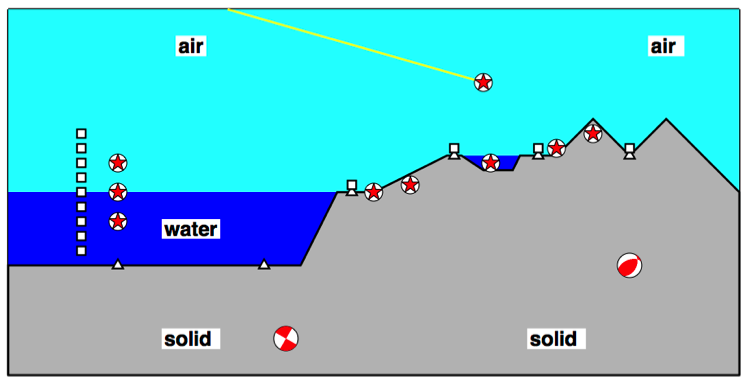Arthur Rodgers (14-ERD-001)
Abstract
Many natural and man-made events of interest, such as earthquakes and explosions, occur near or above the interface between the air, water, and solid earth (see figure). Currently, we cannot jointly model acoustic and seismic signatures from these events with existing tools. Therefore, we plan to develop a coupled seismic and acoustic simulation capability. We will extend our current capability of the WPP (Wave Propagation Program) and SW4 (Seismic Waves, 4th order) codes for seismic motions in solid earth to model energetic sources and motions in fluid regions of the Earth (air and water) and properly account for the flow of energy between the solid and fluid regions. Energetic events such as explosions and earthquakes near the Earth's surface generate motions in the atmosphere and water as well as seismic motions in the solid earth. Simulation of these waves, including propagation biases from the intervening material, enables more accurate inference of source properties. We will accomplish this by extending recent work on elastic waves to acoustics.
Successful execution of this project will expand the variety of energetic phenomena we can model. We expect to produce a simulation capability for coupled seismic and acoustic motions that will be compatible with LLNL's hydrodynamic codes such as the GEODYN compressible solid and fluid dynamics code, and ultimately enable simulation of motions from detailed hydrodynamic source descriptions to far-field seismic and acoustic waves. We will be able to model sources and mechanical motions in the atmosphere and water as well as the solid earth. We intend to simulate seismic and overpressure data collected in near-surface explosion tests and account for measurable weather effects on overpressure, such as wind and sound-speed profiles, as well as sub-surface geologic structure. This will help us understand biases in source estimates that arise from predictable wave propagation effects and establish backwards-modeling capabilities for forensic analysis of explosions.
Mission Relevance
Our research will enable understanding of seismic and acoustic propagation effects that bias source estimates with the development of a simulation capability that is compatible with Laboratory hydrodynamic codes. This capability falls within the Laboratory's core competency in high-performance computing, simulation, and data science. This foundational science is supportive of critical mission needs such as intelligence for nuclear nonproliferation to monitor nuclear explosions, national security to determine the defeat of hard and deeply buried targets, and new ways to extract underground energy more efficiently while minimizing risk and environmental impact.
FY15 Accomplishments and Results
During FY15 we (1) completed the second-generation parallel computer code (SAW4), for modeling the coupled seismic and acoustic case without topography or attenuation, including far-field absorbing boundary conditions; (2) used this code to model purely acoustic and coupled seismic and acoustic cases for flat fluid and solid interfaces; (3) made progress on a nonplanar interface using curvilinear meshes (in which physical geometry is mapped with computational geometry using grids) in the fluid and solid domains, and verified the implementation using smoothly varying fields with manufactured solutions; and (4) determined that the current modeling of point sources, which lead to locally discontinuous solution fields, cause some numerical artifacts that warrant further investigation.
Publications and Presentations
- Sjogreen, B., and N. A. Petersson, “Summation by parts finite difference approximations for seismic and seismo-acoustic computations.” Proc. Intl. Conf. Spectral and High Order Methods, Springer, New York, NY (2015). LLNL-PROC-659087.






